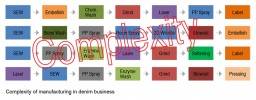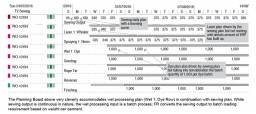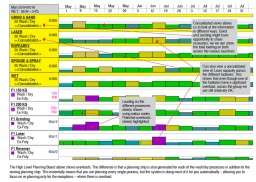Global provider of software solutions, specifically for the fashion industry – from specialist planning and tracking solutions to wider business applications, FastReact has over the years gained wider acceptance in the industry. Regional Head of FastReact (South Asia), Dimitri Suraweera with experience in textiles, footwear and garments, shares his perspective on how FastReact augments its software solutions for denim manufacturers to enable them control over compliance, quality and lead time to maximize profit margins.
Historically, Bangladesh has produced basic styles with bulk production, but now the country is looking at ways in which they can differentiate themselves by providing more ‘fashion’ products, which include embellishing products with print, embroidery, more complexand-special washes, and finishes. Increasingly these value-added processes are being done in-house, but adding machines and skills is not enough and it is essential to have better control and visibility over the manufacturing process; especially due to the complexities involved and greater chances for oversight, so that the companies can optimize gains.

Get the basics right…
In the fashion industry, there is a huge amount of work that goes into getting even a simple garment being delivered to the buyer on time with profit. The coordination of design and development, sampling and approval, dealing with multiple raw materials (often sourced from different countries), production capacity monitoring and controlling, is no easy task, especially when there’re hundreds of styles that need coordination in order to get them manufactured and out of the door each month…!
It is not only about getting the basic capacity planning under control, it is also important to have a structured order confirmation process to ensure that main sewing and supporting production plans are realistic and under control. It is equally essential to link the T&A plus material flows to ensure that they are well-coordinated with the production plan.

Finding the next weakest link or opportunity…
The natural step forward for most companies after creating the T&A is to look for the next weak link in the process and correct it or look for areas of opportunity. For every individual business, this ‘next weak link’ in the chain could be a very different thing. The weak spot could be about managing machinery, supporting the plan, helping in areas such as embellishments and printing, or it could be quick response/replenishment programmes… Each company has a unique weak-point that has to be defined individually.
For most denim manufacturers, the weakest links (and often the most challenging areas to manage effectively) are washing, dry processing and finishing, and these all need to be planned, than coordinated and controlled as per the plan to achieve desired results.
The laundry challenge
An average-sized business in denim has to produce a hundred styles, each with a combination of 15 different wet/dry processes in addition to sewing that ends up with a staggering 1,500 things to plan out and coordinate, along with cutting, printing and embellishment! This is further complicated by the fact that the sequence (routing) of these processes could differ from style-to-style and often the time taken for these processes exceeds the ‘sewing’ time. Any one of these processes can become a bottleneck if the capacity needed is not accurately anticipated, and to adjust one of these processes because of miscalculation, could have a ripple effect on many of the others.
The added complexities of these special finishes mean that the sample approval process is even more challenging, in terms of getting the fit and fabric colours right. There is a need to get washing shades, post-wash ‘feel’, individual dry processes, etc., approved. This means that there’re again a lot more things to coordinate.
How do businesses cope now?
Some of the factors that pose major challenges to manage the complexities of the denim business faster and accurately are:
1. Factories work on estimates, but this is risky as the estimates aren’t accurate.
a. Estimate fixed number of days for post-sewing processes and manage laundry within the time frame. There are two problems with this way of estimation, either one estimates too little time and misses the delivery deadline or gives too much buffer, thus not allowing the company to hit shrinking lead times.
b. Calculate a rough capacity estimate based on number of pieces to be done each month for each process. Problem in this case is that it doesn’t account for variations within the month (what if all the blowouts were needed in the first two weeks?) and also it doesn’t account for the level of complexity in each operation (some processes take a lot longer time than others).
2. The factories try planning in detail but find it too cumbersome in practice.
a. Planning so many operations with different sequences in detail is impossible – especially with the constant changes in the sewing plan, even when putting more people on the job. This job requires them to liaise very closely with each other and it is too much work, and therefore fails.
b. It is very difficult to keep updating the plans as every time something changes and most of the factories end up not bothering to update all the plans. The plan remains static with a hope that things would balance out on their own – often when they don’t, which the factory finds out eventually only a few days before production, then it is too late to fix!

The FastReact solution
After an intense study of the ground realities, FRS concluded that the best solution for speed, accuracy, flexibility and without being overly complicated is to use some core planning rules and automation processes to quickly generate a master macro plan which highlights to the planner capacity/delivery issues. Using the planner’s skill and judgement, with manual intervention to manage the exceptions and test out possible solutions, the management can be offered with different options to review before making the final decision.
First, define the sequence (routing) of the different wet/dry/finishing processes against a style and then do the sewing plan for the same. Based on this sewing plan, the system will automatically plan the other defined processes, taking into consideration a set of pre-defined rules. This ensures that ALL processes are planned and nothing is missed out. As the sewing plan changes, the other schedules are adjusted automatically. This ensures that the company has visibility across all processes and can drill down into the detail where needed, with minimal efforts!
Because the capacities for each process are pre-defined, an accurate loading across all processes can be seen, which allows for identification of any overloads. When initially planning a time-frame for a couple of months ahead, one mainly needs to look at weekly capacities and consolidated views – it is not necessary to look at a daily plan for the longer term because these plans may change – options such as consolidated views that allow to look at overall capacity across different factories for a given process also allows the company to make quick decisions on whether any process is significantly overloaded. Semi-automated planning allows the system to do all this quickly and accurately whilst at the same time gives vital information on capacity utilization for decision making.
Approaching closer to the production date when the sewing plan is largely confirmed and frozen, start looking into daily schedules for the different processes and make manual adjustments to the plan in order to spread it out more evenly as needed. When fine-tuning the plan, any conflicts between plans for different processes are immediately highlighted using colour-warnings.
With FRS, actual production is also recorded to enable a quick overview of the order status to be seen. Since the processes are linked to each other, any potential WIP issues due to planned versus actual variances are also clearly highlighted.
At the end, FRS gives the company the right information at the right time for putting controls to check quality, compliance and lead time to maximize profits.

Post a Comment